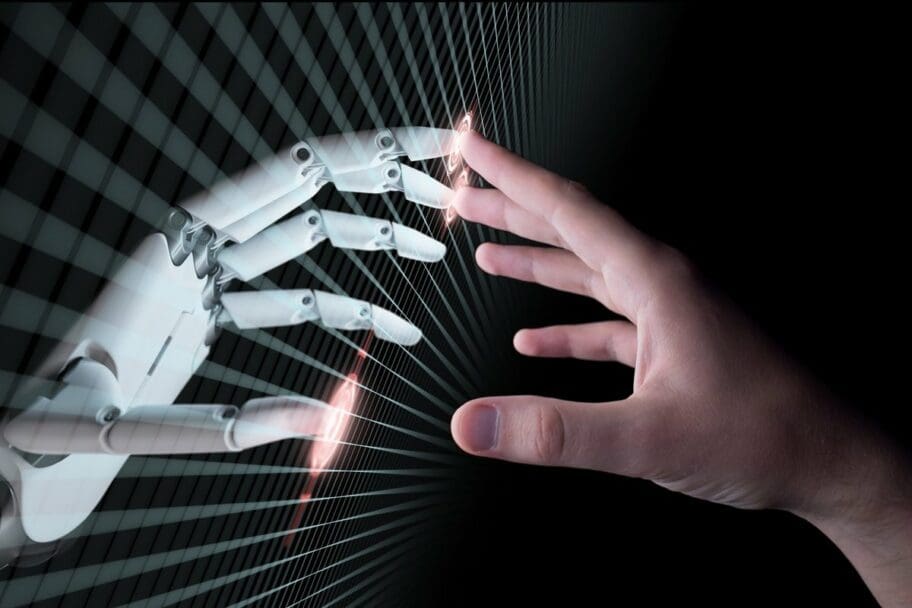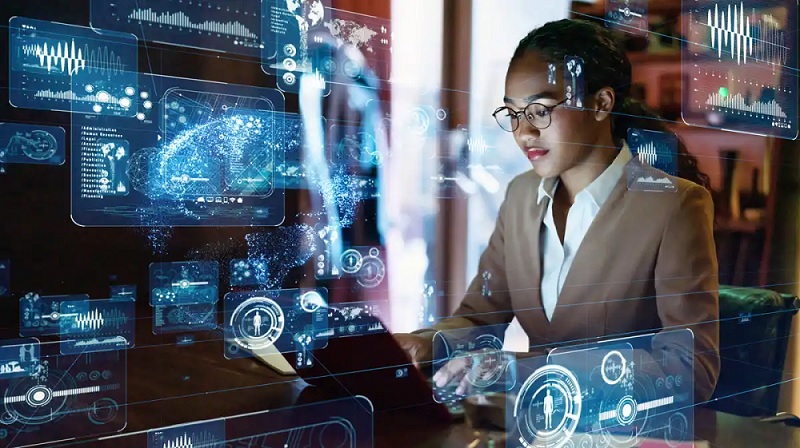Did you know that by 2025, AI and cobots are expected to create more than 12 million new jobs in the workplace, impacting human resources and worker supply, thereby enhancing human capital? Yes, you read that right! The rise of cobots in workforce ecosystems is not a threat to jobs, but an opportunity to enhance the employee experience. The skills of scientific management are revolutionizing traditional practices in ways that integrate cobots seamlessly into our daily work routines.
From cobots enhancing safety in workforce ecosystems to AI-powered machines aiding HR jobs in employee engagement and spot training for frontline employees, the evolution of AI in the workplace is nothing short of phenomenal. This isn't just about automating tasks with cobots and generative AI; it's about augmenting human capabilities, creating more jobs, and crafting a more productive workforce of humans.
Whether it's a small gig involving cobots or an international labour organization conference review on machines and jobs, different types of skills and AI in workplace are being used everywhere for improved communication and increased efficiency. So let's dive deeper into how this fascinating cobot technology is reshaping our office workspaces and workforce ecosystems for jobs!

AI in Workplace: Applications in 2023
Data Analysis and Decision-Making Support
AI technology has revolutionized the way businesses handle data. It's no longer about manual entry and tedious analysis. Now, people analytics and cobots, machines equipped with sensors, can ingest vast amounts of information, analyze it, identify patterns, and provide actionable insights. For instance, companies use people analytics, an example of AI, for forecasting job trends based on historical data or predicting customer behavior to tailor their product offerings.
Moreover, people analytics and machines can also aid management in decision-making processes by providing help in a variety of ways.
-
Identifying potential issues or opportunities based on data analysis.
-
Offering suggestions for policies or strategies.
-
Providing predictive models to guide future business decisions.
This is not some far-off future scenario; remote work is happening right now in workforce ecosystems around the world, involving both workers and companies!
Customer Service Enhancement with Chatbots
Chatbots have become a common sight in customer service scenarios due to the advancements in AI technology. These virtual colleagues are capable of:
-
Handling multiple customer queries simultaneously.
-
Providing instant responses 24/7.
-
Learning from past interactions to improve future responses.
Companies that deploy generative AI chatbots for customer service in the office see an increase in efficiency and customer satisfaction rates, according to people analytics. Plus, generative AI frees up the workforce in ecosystems to focus on complex tasks that require a human touch, thus enhancing people analytics and management.
Predictive Tasks through Machine Learning Algorithms
Machine learning algorithms are another application of ai systems that are reshaping today's workplaces. Businesses use people analytics and AI technology in their management strategies to understand workforce ecosystems. These algorithms are used for predictive tasks such as forecasting sales trends or identifying potential risks before they become problems.
For example:
-
A retail business might use people analytics and machine learning algorithms in management to predict which products remote workers will popularize during the holiday season.
-
An insurance company could use people analytics and these algorithms to identify workers in their management and workforce ecosystems who are likely to file a claim.
By leveraging people analytics and machine learning for predictive tasks in remote work environments, businesses can make proactive management decisions within their workforce ecosystems instead of reactive ones.
Automating Repetitive Tasks and Processes
One significant advantage of AI in managing workforce ecosystems is its ability to automate repetitive tasks, freeing up workers for more complex tasks. This utilization of people analytics in the workplace significantly enhances management processes.
-
Data entry
-
Scheduling online meetings
-
Sending out routine emails
These mundane tasks often consume valuable time that workers could otherwise spend on more critical management work or people analytics, requiring unique skills within workforce ecosystems. By automating these management processes with AI in remote work scenarios, businesses can boost productivity while ensuring accuracy and consistency across workforce ecosystems, benefiting all workers.
Better Time Management with Virtual Assistants
In the modern management of office settings where multitasking and gig work are the norm rather than exception, virtual assistants driven by AI technology offer invaluable assistance to workers in these evolving workforce ecosystems.
-
Organizing schedules
-
Setting reminders for important tasks
-
Managing emails
Management aids workers in better handling their time within workforce ecosystems, enabling people to concentrate on their primary duties without being overwhelmed by administrative responsibilities.
The integration of AI into workforce ecosystems has opened up new avenues for businesses and workers, while also creating new management challenges and risks – especially. But as we've seen from our examples above, when management correctly implements strategies, the benefits for workers and people far outweigh any potential risks or hiccups along the course!

Transformative Benefits of Workplace AI
Efficiency and Productivity Enhancement
One of the standout benefits of integrating AI in the workforce is the significant boost in efficiency and productivity it brings to workers. This management tool is particularly beneficial to people in the workplace. Automation powered by AI takes over repetitive, time-consuming tasks, freeing up the workforce to focus on more strategic, high-value work. This not only benefits workers but also reduces the risks people face in mundane jobs. For instance, AI-powered chatbots can manage frontline customer service tasks, allowing the workforce, specifically people in customer service roles, to handle more complex inquiries. This not only optimizes workers' abilities but also mitigates risks associated with task overload.
-
Automated data entry: Reduces manual labor for workers and speeds up processes, minimizing risks for people.
-
Intelligent scheduling: Optimizes task allocation for better productivity.
-
Predictive maintenance: Identifies potential equipment failures before they occur, minimizing downtime and risks for workers, ensuring people's safety.
Through such functionalities, companies can reap the benefit of increased output without extra labor costs or extended working hours for their workers. This allows people to avoid the risks associated with overwork. This directly impacts an organization's bottom line and the people within it, while improving the overall employee experience as workers are relieved from mundane tasks.
Enhanced Accuracy with Reduced Errors
Another key benefit that AI brings to the table is improved accuracy for workers and people. Errors made by workers are inevitable but can be costly in business operations, affecting people involved. By leveraging AI tools, organizations can significantly reduce errors for workers and people.
-
Data analysis: AI tools provide accurate insights to workers and people by analyzing vast amounts of data without fatigue or bias.
-
Quality control: Machine learning algorithms identify anomalies and defects faster than human workers, providing people with more accurate results.
-
Financial management for workers: Automated systems ensure precise calculations and financial reporting for people.
With reduced errors from workers comes enhanced reliability, which translates into a better customer experience as well as increased trust from stakeholders.
Data-driven Decision Making
AI analytics play a critical role in facilitating informed decision making within organizations, particularly for workers. These intelligent systems sift through massive datasets to uncover patterns and trends that would otherwise go unnoticed by human workers and analysts.
-
Predictive analytics: Helps forecast market trends for strategic planning.
-
Customer behavior analysis: Provides insights into consumer preferences for personalized marketing campaigns, aiding workers in their tasks.
-
Risk assessment: Evaluates potential threats to mitigate financial losses.
By providing data-driven insights, AI empowers businesses and workers to make proactive decisions that align with their strategic objectives while enhancing their competitive advantage in the marketplace.
Cost Savings through Intelligent Systems
Labor-intensive tasks not only drain resources but also increase operational costs for workers. With smart automation brought about by workplace AI, organizations stand to save considerably on labor costs for their workers.
|
Task |
Traditional Approach |
With Workplace AI |
|---|---|---|
|
Data entry |
Manual input leading to higher labor cost & possible errors |
Automated input lowering cost & reducing errors |
|
Customer support |
Hiring more workers for 24/7 staff support leading to increased payroll expense |
Use of chatbots offers workers round-the-clock service at minimal cost. |
The cost savings achieved by workers can then be channeled towards other strategic initiatives aimed at driving growth.
Boosting Employee Satisfaction
Workplace satisfaction is intrinsically linked with workers' performance and retention rates. By taking over mundane tasks, workplace AI allows workers to engage in more meaningful work thereby boosting job satisfaction levels.
-
Personalized learning programs driven by machine learning improve skill development for workers.
-
Virtual assistants help manage workload effectively reducing stress levels.
-
Real-time feedback systems promote personal growth and professional development for workers.
Thus, integrating AI into workplace processes goes beyond operational efficiency; it plays a pivotal role in shaping a positive work culture that encourages workers' innovation and fosters employee loyalty.
AI and SMB Owners: A Perspective
Leveraging Cloud-Based AI Solutions
SMBs are increasingly turning to affordable, scalable cloud-based AI solutions. The use of such services has allowed workers to streamline their operations, increase efficiency, and improve customer service. For instance, managers at a small company can use AI-powered analytics tools to identify trends in customer behavior and workers' performance, enabling them to make data-driven decisions that enhance the bottom line.
Implementing these solutions is not without challenges. The introduction of new technologies like artificial intelligence may pose risks for workers in SMBs. These include potential OSH risks related to data security and privacy for workers, as well as psychosocial risks associated with workers' adaptation to new systems. However, with careful planning and risk management strategies in place, SMBs can navigate these challenges effectively for their workers.
Gaining Competitive Edge through AI Tools
Smart use of artificial intelligence tools can give SMBs a significant competitive edge. Companies that leverage AI effectively often outperform their competitors who do not, particularly in terms of worker productivity. For example:
-
An e-commerce company might employ workers to manage an AI-powered chatbot that provides 24/7 customer support.
-
A manufacturing firm could implement an AI system for supply chain management, reducing costs and improving efficiency for its workers.
-
A restaurant owner might employ an AI tool for inventory management, minimizing food waste and maximizing profitability for the workers.
Despite the obvious benefits, some small businesses hesitate.
Case Studies: Profitability through Workplace AI
Several case studies show improved profitability and worker efficiency with strategic application of workplace AI among SMBs.
-
Company X's workers used an external contributor's cloud-based CRM solution integrated with an intelligent sales assistant which resulted in a 20% increase in sales over six months.
-
Company Y leveraged on a people analytics platform for work that helped reduce employee turnover by 15%, leading to significant savings on recruitment costs related to work.
-
Company Z implemented an automated invoicing system for work, powered by machine learning algorithms. This work reduced manual errors by 30%, saving both time and money.
These examples highlight how investment in workplace AI can have tangible effects on a company’s bottom line.
Challenges & ROI
Investing in artificial intelligence is not without its challenges for SMB owners. There's the initial work-related financial outlay required for software or hardware purchases; there may also be ongoing costs related to maintenance or upgrades at work; plus training staff members at work on how to use the new technology effectively.
However, despite these work-related hurdles, the potential return on investment (ROI) makes it worth considering.
-
Improved productivity: Automating routine tasks allows staff members more time for high-value work.
-
Enhanced decision-making at work: Intelligent analytics provides insights into business performance.
-
Better work efficiency in customer service: Chatbots can handle common work-related queries quickly and efficiently.
The Concept of Hybrid Work
Hybrid work, the new wave in work design, is a model that combines remote and on-site work. It's a variety of work roles wrapped into one, offering job flexibility like never before. This model has been gaining traction due to its potential to address the double burden and overload often experienced by workers in traditional setups.
Artificial Intelligence (AI) plays an integral role in facilitating this hybrid work model. AI-powered collaboration platforms have become indispensable tools for managing workforce ecosystems. These platforms provide:
-
Seamless communication channels
-
Efficient task management systems
-
Real-time progress tracking
Furthermore, AI can automate routine work tasks, freeing up time for more complex work responsibilities. This work automation not only boosts productivity but also enhances job satisfaction as employees focus on high-value tasks at work.
The benefits of advanced technologies like AI in supporting hybrid work models are manifold:
-
Increased Work Productivity: With AI taking care of mundane tasks, work employees can concentrate on strategic thinking and creativity.
-
Enhanced Collaboration at Work: AI-powered tools facilitate real-time collaboration among team members at work, regardless of their physical location.
-
Greater Flexibility: Employees can choose where they want to work from, leading to better work-life balance.
The impact of hybrid working conditions aided by digital tools such as AI on employee productivity cannot be overstated. A study found that remote workers were 13% more productive than their office-bound counterparts. This increase in work productivity is attributed to fewer distractions and increased autonomy.
Moreover, the flexibility offered by hybrid working conditions fosters greater collaboration among team members spread across different locations. For instance, online gig workers can collaborate on projects using cloud-based tools powered by AI.
Looking ahead at future trends related to the hybrid workforce powered by technological advancements, we see an increasing shift towards gig work and a diverse labor force:
-
Gig Work: More people are opting for freelance or contract-based jobs instead of full-time employment.
-
Diversity: Hybrid work models allow organizations to tap into a global talent pool leading to increased diversity within teams.
In terms of theory and work practice around these trends, it's clear that organizations must adapt their work strategies accordingly.
-
Embrace Technology at Work: Invest in robust AI-powered tools that support remote collaboration in the workplace.
-
Foster Diversity: Leverage the global talent pool made accessible through remote work arrangements.
-
Support Gig Workers: Provide resources and support structures for gig workers who may face precarious working conditions.
To sum up this section without a conclusion - the concept of hybrid work is transforming how we perceive 'work'. By leveraging artificial intelligence capabilities within these new models – from enhanced collaboration platforms to automating mundane tasks – businesses can reap significant benefits including improved productivity and increased worker satisfaction while preparing themselves for an increasingly diverse future workforce landscape.

Exploring AI Impact on Industries
Healthcare Revolutionized by AI
Artificial Intelligence's influence on the healthcare industry's work is profound, with telemedicine and diagnostics powered by this technology. Companies in the healthcare sector are leveraging AI to deliver remote medical services, enhancing accessibility for patients irrespective of their geographical location, and revolutionizing the way work is conducted in this industry. For instance:
-
Telemedicine platforms at work use AI algorithms to analyze patient symptoms and provide preliminary diagnoses.
-
Advanced diagnostic tools powered by AI can detect complex health conditions with remarkable accuracy in the field of work.
AI-driven applications have also revolutionized disease prediction and prevention in the field of work. By analyzing vast datasets, these work applications can identify patterns that indicate a higher risk of certain diseases, enabling early intervention in the work environment.
Retail Sector Transformed
The retail sector has not been left behind in adopting artificial intelligence in its work. Many companies now offer personalized shopping experiences enabled via Artificial Intelligence algorithms, integrating work processes. This transformation is evident in several ways:
-
Personalized work product recommendations: Based on a customer’s browsing history and work-related purchase behavior, AI systems suggest products that align with their professional preferences.
-
Work-related price optimization: AI tools analyze work market trends, demand fluctuations, and competitor pricing to determine optimal product prices in the workplace.
-
Work in inventory management: With predictive analytics capabilities, AI helps retailers maintain optimal stock levels for their work, reducing storage costs and preventing stockouts in the workplace.
This shift towards personalization in the retail work environment has redefined customer expectations from retail brands.
Manufacturing Industry Evolution
Artificial Intelligence has brought significant changes within the manufacturing industry as well. Automation & predictive maintenance facilitated by Artificial Intelligence have become commonplace in factories worldwide.
-
Automated assembly lines driven by machine learning algorithms have significantly boosted production efficiency while minimizing human error.
-
Predictive maintenance tools monitor equipment condition in real-time, predicting potential failures before they occur and scheduling timely repairs or replacements.
These advancements have led to safer work environments, reduced downtime, cost savings on repairs and replacements - thus increasing overall productivity.
Disruption in Financial Services
The financial services sector too has witnessed disruption caused by Artificial Intelligence applications such as fraud detection and risk assessment.
For example:
-
Fraud Detection: Machine learning models trained on past fraudulent transactions can detect anomalies indicating potential fraud.
-
Risk Assessment: Credit scoring models leverage AI to assess borrower reliability more accurately than traditional methods.
These developments have made financial transactions safer while improving service delivery speed and accuracy.
Education Sector Transformation
Lastly, the education sector has seen an evolution due to adaptive learning platforms driven by Artificial Intelligence. These platforms tailor educational content based on each learner's strengths and weaknesses – creating personalized learning paths that enhance understanding and retention of knowledge. Here are some notable transformations:
-
Adaptive testing: Exam questions adapt based on student performance – offering a more accurate measure of understanding than standard tests.
-
Intelligent tutoring systems: These provide individualized instruction based on a learner’s needs – akin to having a personal tutor available round-the-clock.
Measuring Work Efficiency with AI
Quantifying Improvements through Tools
In the era of artificial intelligence (AI), numerous tools have surfaced that help quantify improvements achieved via its implementation in the workplace. These tools leverage machine learning, analytics, and algorithms to monitor efficiency gains. Think about it this way: you've got a virtual assistant that not only performs repetitive tasks but also tracks how well these tasks are done.
Consider people analytics tools. They utilize big data to analyze patterns related to human capital, providing insights into employees' performance and productivity levels. Then there's cobot technology, where machines work alongside labour forces for more efficient operations. These aren't just fancy gadgets; they're game-changers that revolutionize how we measure work efficiency.
Common Metrics across Industries
The use of AI in workplaces isn't limited to specific sectors. Across industries, several metrics commonly gauge efficiency gains attributed to AI usage:
-
Time savings: How much time is saved on manual or repetitive tasks due to automation?
-
Cost savings: What's the reduction in operational costs as a result of implementing AI?
-
Performance management: Are there improvements in key performance indicators (KPIs) after deploying AI?
These metrics don’t just give us numbers; they tell stories of increased productivity levels and adoption rates pertaining to workplace artificial intelligence.
Correlation between Productivity & Adoption Rate
There's an interesting correlation between increased productivity levels and adoption rate concerning workplace AI—a sort of symbiotic relationship if you will.
On one hand, as companies adopt more intelligent systems like algorithmic management or collective intelligence platforms, their productivity spikes up—fewer errors mean less rework and faster processes lead to more output.
On the flip side, witnessing these benefits encourages other organizations to jump on the bandwagon and integrate similar technologies into their workflows—thus increasing overall adoption rate.
Real-Life Examples
But enough talk—let’s see some real-life examples showcasing significant performance enhancements directly linked with deployment level concerning workplace AI:
-
Amazon uses robots in their warehouses for picking and packing orders which has doubled their efficiency.
-
UPS uses an algorithm called ORION that optimizes delivery routes saving hundreds of millions annually.
-
IBM’s Watson helps doctors diagnose diseases faster and more accurately than traditional methods.
These examples aren’t just isolated incidents; they represent a global trend towards embracing technological advancements for improved work efficiency.
Calculating ROI & Global Methodologies
Now let's dive into methodologies adopted globally towards calculating ROI associated with investments made towards ai-powered digital transformation initiatives:
-
Direct Measurement: This involves comparing pre-AI cost structure with post-AI cost structure.
-
Incremental Value Approach: Here we calculate additional value created by AI over existing systems.
-
Forecasting Future Savings: This method projects future cost savings based on current data trends.
Remember though—the best approach depends on your organization’s unique circumstances and goals!
Future Projections for AI
Look, let's cut to the chase. It's crystal clear that AI is revolutionizing the workplace, and it ain't slowing down anytime soon. From streamlining operations in small businesses to boosting efficiency in major industries, AI is proving its worth every day. And with hybrid work becoming the new norm? You bet your boots AI will be there to make it all run smoothly.
But remember, change isn't always easy. Some folks might resist this tech-driven shift. That's why it's crucial to keep an open mind and stay informed about how AI can benefit you and your business. Take a leap of faith! Embrace the future with AI today and see how it transforms your work tomorrow.
FAQs
What are some benefits of using AI in my business?
AI can streamline operations, increase efficiency, provide insights through data analysis, automate repetitive tasks and improve customer service.
How does AI impact various industries?
AI has a transformative effect on many industries like healthcare where it aids diagnosis, retail where it personalizes shopping experiences or manufacturing where it optimizes production processes.
Is AI relevant for small businesses?
Absolutely! Even small businesses can reap huge benefits from implementing AI solutions such as chatbots for customer service or automated scheduling systems.
What is hybrid work and how does AI support it?
Hybrid work refers to a mix of remote and office-based work. AI supports this by enabling effective collaboration tools, automating administrative tasks and providing analytics for better decision making.
Can I measure work efficiency with AI?
Yes! With advanced analytics capabilities, you can use AI to track performance metrics and identify areas of improvement in real-time.

Article by
Titus Mulquiney
Hi, I'm Titus, an AI fanatic, automation expert, application designer and founder of Octavius AI. My mission is to help people like you automate your business to save costs and supercharge business growth!
